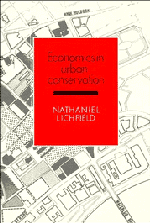Book contents
- Frontmatter
- Contents
- List of diagrams, tables and plans
- Preface
- Acknowledgements
- Introduction
- Part I Planning and management in the conservation of the urban system
- 1 Life cycle in the urban system
- 2 Planning and management of urban resources
- 3 Planning for urban conservation
- Part II Conservation of the cultural built heritage
- Part III Economics in urban conservation
- Part IV Selected tools of economic analysis for project evaluation
- Part V Case studies in the economics of conservation of the CBH
- Notes
- Bibliography
- Index
1 - Life cycle in the urban system
Published online by Cambridge University Press: 10 November 2010
- Frontmatter
- Contents
- List of diagrams, tables and plans
- Preface
- Acknowledgements
- Introduction
- Part I Planning and management in the conservation of the urban system
- 1 Life cycle in the urban system
- 2 Planning and management of urban resources
- 3 Planning for urban conservation
- Part II Conservation of the cultural built heritage
- Part III Economics in urban conservation
- Part IV Selected tools of economic analysis for project evaluation
- Part V Case studies in the economics of conservation of the CBH
- Notes
- Bibliography
- Index
Summary
A concept of the urban system
We use the term ‘urban’ to convey a simple image: the familiar concentration of bricks and mortar, varying enormously in scale from the village to the metropolis and conurbation, which contrasts with the rural. But the image is over simple. Webber has pointed out a second meaning: the relatively sophisticated urban life-style which can be obtained in the rural area by those having a high, i.e. urban, standard of living (television, radio, cars, private planes, etc.).
There is a further dimension to the term which is significant for us. No urban area, except perhaps the remotest jungle-bound or desert village, is self-contained in that only residents use it. In contrast, the typical town is used in part by residents and in part by others who visit for various activities (work, education, recreation, etc.); and some of the town's residents will travel outside for their activities (work, recreation, etc.). Thus any town can be defined in relation to this functional criss-crossing of ‘urban activities’. This definition in itself must bring in the ‘regional system’ in which the town functions. In this sense, the ‘urban’ embraces the ‘regional’ system within which it functions.
Any town or region thus comprises a diverse array of physical elements (buildings of all kinds and spaces between them, parks, roads, etc.) and of diverse human activities (shopping, production, recreation, etc.). In the diversity there is some order, for otherwise people would not get to work on time, they would not have the milk bottle on the doorstep each morning, and they would not meet in groups for religion, culture, etc. Diagrams 1.1 and 1.2 give one version of this order.
- Type
- Chapter
- Information
- Economics in Urban Conservation , pp. 11 - 34Publisher: Cambridge University PressPrint publication year: 1989



